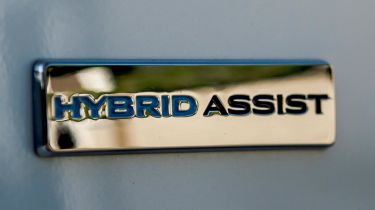What is a mild hybrid (MHEV)?
What is a mild hybrid car – also known as a mild hybrid electric vehicle, or MHEV – and how do they work?

If you're looking at buying a new car, no matter what kind of car you are looking for there’s a good chance it will be offered in hybrid form. The word 'hybrid' can be used to describe any car with some combination of an internal combustion engine and electric power but there are several different types of hybrid car that work in different ways.
In this guide we’re concerned with mild hybrids or MHEVs (mild-hybrid electric vehicles). Like all hybrids, mild hybrids use electric power to boost fuel economy and lower emissions but a mild hybrid usually can’t drive on electric power alone and in many cases the electrical system doesn’t provide drive to the wheels at all.
Other types of hybrid car include plug-in hybrids and full hybrids. Full hybrids can drive for short distances on electric power, typically a mile or two at low speeds. Plug-in hybrids have a larger battery that can be charged from a power supply via a cable and the latest models can typically drive for well over 30 miles on electric power alone. Mild hybrid electric vehicles (MHEVs) differ in that the electric motor always works in unison with the petrol or diesel engine, most can’t drive solely on electric power for any distance. When driving mild hybrids, they can feel little different to standard petrol or diesel cars, but typically offer small fuel economy gains.
Strict emissions regulations mean almost every manufacturer is incorporating mild-hybrid technology into its cars these days, so it's important to understand exactly what this technology is. Read on to find out more.
How does a mild hybrid car, or MHEV, work?
The setups of mild hybrids differ from model to model, but the most common use an upgraded electrical system with a larger battery pack in addition to the normal 12-volt battery that you can find in an ordinary combustion car. Often, this is a 48-volt system that features an integrated starter-generator, which acts as both a starter motor and a power bank to assist the engine.
Some 48-volt systems use a lithium-ion battery, while some have more traditional lead-acid batteries. Either way, instead of replacing the 12-volt unit, the 48-volt unit works with the regular battery. It’s connected to a motor and an electric supercharger, and takes over duties such as powering the air-conditioning, catalytic converter and engine fan from the 12-volt battery.
The 48-volt battery also supplies power to the electric motor and supercharger, allowing the car to accelerate slightly faster and smoother than a purely petrol-engined example. In some models, such as the latest high-end Audis, the 48-volt system can turn off the car’s engine for up to 40 seconds when coasting. Approaching a red light or roundabout, if the signal turns green or a gap appears, and you release the brake, the combustion engine starts immediately. The car can then accelerate without delay.
A different example is Suzuki’s SHVS (Smart Hybrid Vehicle by Suzuki) system, available in the Swift and Ignis models. It incorporates a ‘starter generator’ and a relatively small battery pack. The generator’s built-in motor can be used to boost the engine when under hard acceleration, as well as allowing the car’s stop-start system to bring the engine back to life more smoothly, thanks to a belt-drive system.
Benefits of a 48-volt mild-hybrid system
One of the key benefits mild-hybrid systems offer is improved fuel efficiency and reduced pollution compared to non-hybrid engines. Engineering firm Delphi, which has developed a 48-volt mild-hybrid system, says that it can offer a 25% increase in low-end torque, a 10-15% boost in fuel efficiency and a 25% reduction in CO2 emissions compared to a traditional 12-volt system.
Further benefits to a mild-hybrid system include the potential to reduce harmful emissions such as nitrogen oxide (NOx). Tyre and automotive technology company Continental has been working on 'super-diesel technology’ that uses a 48-volt mild-hybrid system to cut NOx emissions from diesel cars by 60%. Continental has developed an electrically heated catalytic converter that relies on the 48-volt battery to rapidly heat it to maximum operating temperature.
A normal catalytic converter relies on the engine to bring it up to temperature and it only works properly once this has happened. Using an engine to heat it up takes time, but thanks to the 48-volt system, this can now be done faster, which reduces tailpipe emissions.
Mild hybrids (MHEVs) vs full hybrids (FHEVs)
A 'full hybrid' system (also known as a 'parallel hybrid' or 'self-charging hybrid') has a larger and heavier battery pack than a mild hybrid, which increases the car’s overall weight. The systems can manage to run on full electric power at low speeds and over short distances.
Mild-hybrid systems are smaller and lighter, which makes them cheaper to build. However, because mild hybrids are lighter and smaller, they also can’t run the car on electric power alone – even for the very short distances managed by full hybrids. This means they pollute more than a regular hybrid in most driving conditions.
Are mild hybrids (MHEVs) road-tax-exempt?
Unfortunately, not. Since the new vehicle excise duty (VED, also known as road tax) bands came into effect in April 2017, only zero-emission vehicles are exempt from paying until 2025.
As mild hybrids emit carbon dioxide, owners are required to pay road tax. However, these cars are officially classified as 'alternatively fuelled vehicles' (AFVs) by the UK government, which means they benefit from a £10 reduction per year compared to regular cars.
Does a mild hybrid feel different to a normal car?
There are no significant differences between a mild hybrid and a petrol car. For the most part, these systems enhance the car’s start-stop feature, allowing you to coast to a stop without engine power, rather than having the engine cut out at the last moment.
The internal combustion engine still does all the driving, although in some cars, the battery may provide additional assistance when accelerating. You may notice a slight difference when braking, as some systems use regenerative braking to recharge the mild-hybrid batteries.
Most Popular

EV Deal of the Day: Dacia Spring is amazingly good value at £116 per month


